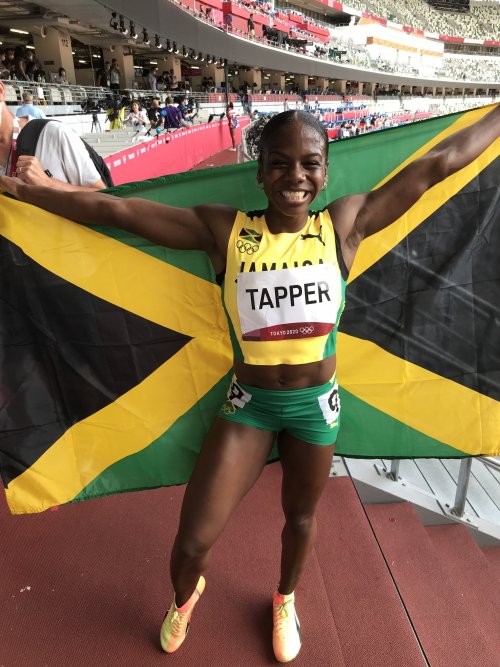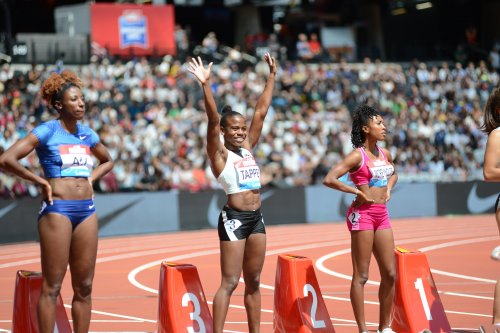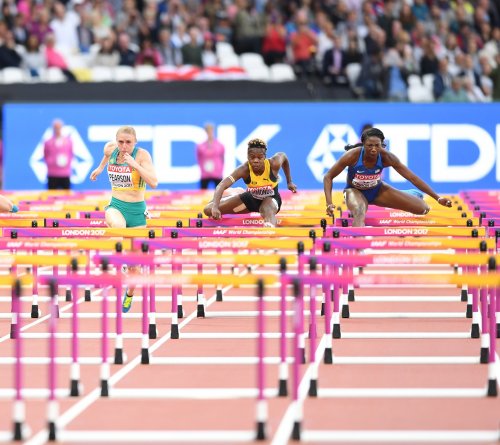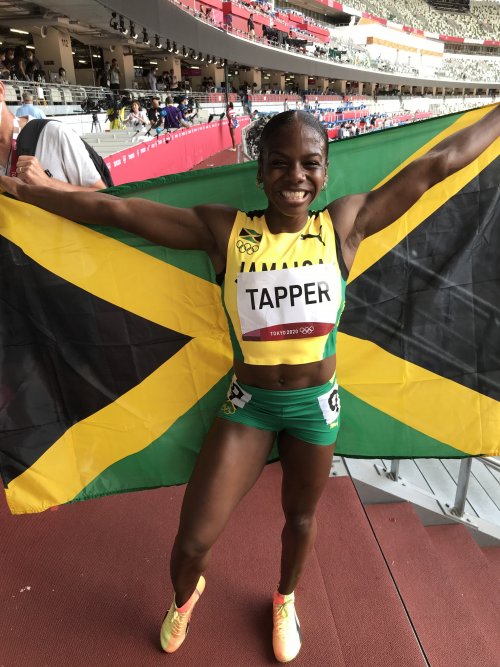 Megan Tapper, 2021 Tokyo Olympics, photo by British Athletics
Megan Tapper, 2021 Tokyo Olympics, photo by British Athletics
Megan Tapper may have been one of the happiest Olympic bronze medalists in Tokyo! I remember watching her on TV and thinking, Megan gets it. The Olympic Games is watched by billions, and only 2,000 track & field athletes compete, from 209 countries in the global games. Stuart Weir wrote this piece on Megan.
Megan Tapper
Megan Tapper describes 2021 as a difficult year which had a good ending. In 2019 she had taken bronze in the PanAm Games and reached the final of the World Championships in Doha where she hit a hurdle and failed to finish. Then the Pandemic happened meaning that her 2020 season was restricted to five meets, none of them very distinguished.
 Megan Tapper, photo by Martin Bateman
Megan Tapper, photo by Martin Bateman
Going back, her route to becoming a sprint hurdler is an interesting one: “I was a dancer first and then I did gymnastics and cheer leading. I dabbled in some other sports like netball and synchronised swimming before I found track and field. My first event was long jump and in middle school I won at the schools’ championships but I found that long-jump hurt my muscles, bones and shins. Long jump is a lot of pounding. So I tried hurdles”. And, as they say, the rest is history. Her early 2021 season races were a struggle, often 13 something. Then in her final meet before Tokyo in American Track League, Trabucco Hills HS, Mission Viejo, a 12.48.
Having a coach who is located in Austria caused some logistical issues as she explained: “My coach, Philipp Unfried, is Austrian; he lives in Austria. Because he is the national coach and has a club in Austria, he couldn’t come to Jamaica so I had to go to him. The year has been extremely difficult but I definitely had the right team around me to support me and give me the necessary resources to help me to get where I am now”. Her Husband, Mathue, also has a role in her coaching set-up.
 Megan Tapper, Sally Pearson, photo by British Athletics
Megan Tapper, Sally Pearson, photo by British Athletics
Having reached the World Championship final in 2019, she told me her Tokyo “expectations were definitely to make the final and vie for a medal”. She ran 12.53 in the Tokyo prelim and 12.62 in the semi – second each time – to make the Olympic final. She was allocated lane nine – the lane she had had in the 2019 World final which had gone wrong: “Getting lane nine again was nerve-wracking so I called upon my mental coach, Wesley Morris, who helped me through dealing with lane nine and to relieve any anxieties I had before the race about lane nine”. She added that “it is important to have the right team around you. Wesley Morris has a special technique that he uses to help with different situations that I might be in”.
 Megan Tapper, photo by British Athletics
Megan Tapper, photo by British Athletics
She ran 12:55 in the Olympic final to take bronze. We talked about athletes in the sprint hurdles who had run fast races in the prelim and semi but not in the final. The secret she feels is her “mental toughness”, again crediting her team for helping her, explaining: “Actually the lessons were before the final. I learnt a lot from my mentor, Greg, recognizing that every race is just a race. Despite the importance of a race, all you can do is execute it to the best of your ability. You can’t ask for anything more and you must make sure you don’t do anything less”.
She told me she was not fazed by running the most important race of her career in an empty stadium: “I’m not one to focus on the fans. What did really affect me was the medal ceremony because that’s when you really would like fans to cheer but it’s OK, I am still an Olympic medallist. I am grateful for the experience. Grateful no matter what”.
This was her second Olympics but a totally different experience. Again, she just focussed on the job and made the best of it: “My race was the week after I came into the village so I didn’t have a whole lot of time to prepare, while enjoying the whole experience I used the two days after my race to soak up as much as I could. We were not allowed to do any sightseeing etc. but I have to say that Japan did an amazing job. Despite Covid it has been my best Olympic experience by far. The travel from the village to the stadium was beautiful, so picturesque and beautiful. The Japanese people were so welcoming, kind and friendly. It was a great experience”.
 Megan Tapper, photo by Stuart Weir
Megan Tapper, photo by Stuart Weir
Megan Tapper is 5 foot 1 inch, I wondered if she saw her size as a disadvantage: “Actually, no”, she told me. “I find it pretty easy getting over the hurdles. While the tall girls are able to clear them more easily, I am able to run faster between the hurdles than they are because they might have to cut their stride not to hit the hurdle. Because my legs are shorter, I can run full out. While I have disadvantages, so do they. It can be nerve-wracking watching Jasmin Comacho-Quinn because she just steps over hurdles like they are small. Watching her hurdle, you can definitely see the advantage of being tall. But at the end of the day, life isn’t fair and you work with what you have and make the best of it. Anything is possible. I don’t necessarily have a stride pattern; I just run 1-2-3 hurdle, 1-2-3 hurdle”. It seems to work.
“As humans”, she continued, “we have the tendency to limit ourselves, saying you have to be this height or that size but I believe anything is possible as long as you have the right mentality and the right resources around you”.
Winning an Olympic medal has taken her to a new level and set the bar higher as she contemplates the future: “I hope so! And I’m so excited because the next four years is going to be so good with the Olympics, three World Championships and a Commonwealth Games”. Bring it on!
Author

Since 2015, Stuart Weir has written for RunBlogRun. He attends about 20 events a year including all most global championships and Diamond Leagues. He enjoys finding the quirky and obscure story.
View all posts




















